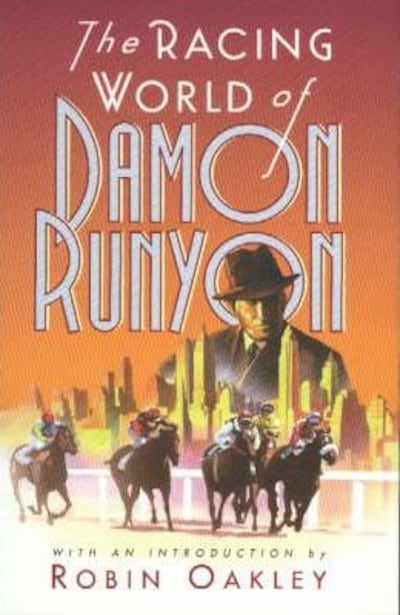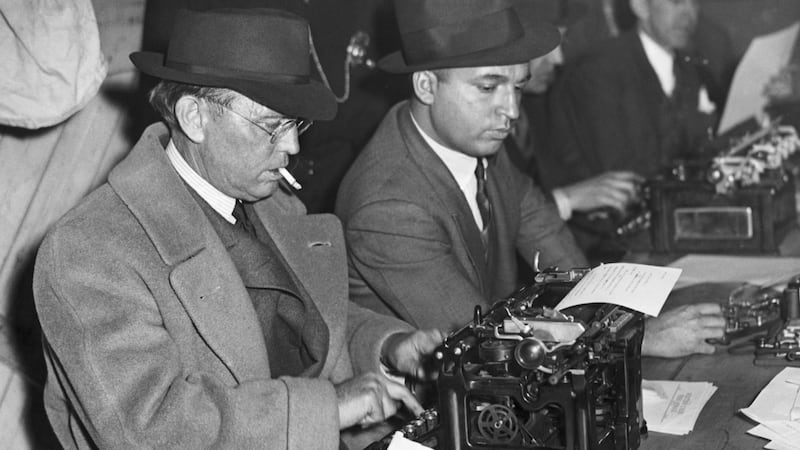Not many writers have their names become adjectives. Everyone understands Orwellian. Homeric is obvious too. Damon Runyon overcame being a newspaper columnist to get “Runyonesque” into the lexicon. Apart from literal definitions it’s easy to get what it means.
It’s 1930s depression era New York and the shady characters snaking their way around the boozers, clip-joints and backroom casinos. It’s wise-cracking gangsters and guys on the make, always with an undertow of violence and a terrible optimism that fortunes might yet change for the better.
Even the Broadway sheen of Guys & Dolls can’t gloss over the gritty desperation contained in Runyon’s short stories on which the famous musical is based. It’s what makes “Runyonesque” firmly of its time and yet timeless. At its heart is the racetrack.
In 1922 the then 42-year-old Runyon was one of the best-known sports hacks in America. That summer, burned out from working the baseball beat for years, he moved upstate to Saratoga for a change of pace. It changed his life.
A sample of his racing columns up to 1936 is in the collection I Got the Horse Right Here. However, it is in the fiction of one of America’s greatest short story writers that the back-stretch comes vividly to life.
The Racing World of Damon Runyon, published in 1999, contains umpteen picaresque characters crammed with the peccadilloes and prejudices that immediately define the age from which they emerged.
But the eternal rakish fascination of trying to identify what horse might beat another means they endure.

The character Hot Horse Herbie in the story Pick The Winner is so called “because he can always tell you about a horse that is so hot it is practically on fire, a hot horse being a horse that is all readied up to win a race, although sometimes Herbie’s hot horses turn out to be so cold they freeze everybody within 50 miles of them”.
Herbies today don’t have a tattered trilby or nervously keep one step ahead of the Pinkertons while somehow staying engaged to Miss Cutie Singleton.
But what else is the vast network of betting information and variously advertised tipping lines apart from a digital Hot Horse hustle, always fighting the suspicion that if the sure thing really is so sure, then why the necessity to hawk it?
Part of the magic of Runyon’s racing stories is the contradiction of how so much exhaustive ducking and diving goes into the making of supposedly easy money.
When another character, Sam the Gonoph, says in A Nice Price “I long ago come to the conclusion that all life is 6 to 5 against” such grim wisdom has obviously been hard won.
Runyon isn’t interested in the sport of kings so much as the sport of spivs. “The Boswell of Broadway” loved the ponies and wound up owning racehorses of his own. But what really enthralled him was the circus around them.
It’s distinctly and vividly a depression era vernacular. The absence of “scratch” or “potatoes” is a recurring theme through the lives of characters living on their wits.
They include memorably titled figures such as Harry the Horse, Bookie Bob, Madame La Gimp and Nicely-Nicely Jones – “what he does for a livelihood is the best he can, which is an occupation that is greatly overcrowded at all times along Broadway”.
They possess their own argot, the snappy, finger-snapping crackle of a super-charged sense of New York. These are stories that are laugh-out-loud funny, genial and even sentimental sometimes. But they also contain a brutal bleakness.
It’s hardly surprising from a writer who once said: “The race is not always to the swift, not the battle to the strong, but that’s the way to bet.”
Nicely-Nicely Jones ends up in a Newark hospital with such a severe case of pneumonia that the attending doctor writes 100, 40 and 10 on the chart over his head.
“It comes out afterwards that what the physician means is that it is 100-1 in his line that Nicely-Nicely does not recover at all, 40-1 that he will not last a week, and 10-1 that if he does get well he will never be the same again.
“Well, Nicely-Nicely is greatly discouraged when he sees this price again him, because he is personally a chalk eater when it comes to price, a chalk eater being a character who always plays the short-priced favourites, and he can see that such a long shot as he is has very little chance to win.
“In fact he is so discouraged that he does not even feel like taking a little of the price against him to show.”

The Runyon voice is all there, the deceptive stylised construction and the perpetual present tense. Apparently there is only one instance of a past tense in all of the stories and it’s odds-on that was a misprint. It still crackles today and the influence is spattered over New York’s image of itself.
The aggressive “Noo Yawk” oneliner is rooted in Runyon. The idea that lowlifes could have a code of honour is at the heart of every Scorsese movie. Tony Soprano going operatic over the racehorse Pie O My didn’t come out of a vacuum.
His influence on racing’s self-image however has travelled far beyond the Big Apple playgrounds of Aqueduct and Belmont.
The sport’s ingredients have always been seasoned with a raffish dash that can be wishful thinking a lot of the time but which nevertheless continue to pull at the popular imagination 75 years after Runyon’s death.
An indulgence barely given to anything else is granted to scurrilous behaviour when it comes wrapped in the romance of the turf. Rare is the racing fan that never appreciates a little sulphur when it comes to beating the odds. No one in on a plot ever runs to the stewards to complain.
That’s still a sure thing in Sandown and Sha Tin as much now as it was in Saratoga and Hialeah 90 years ago.
Just as sure is the fascination of identifying which horse can run fastest from A to B and how the game exerts a fascination for countless people of all financial stripes. “Runyonesque” taps into how the only race that counts is the next one.
It’s a promise has always exerted a pull on those whose idea of hell is 9 to 5 and yet wrestle with a fatalism that’s the all but inevitable consequence of having your financial future dependant on the fluctuating moods of a highly-strung thoroughbred.
Perhaps it’s no coincidence then that perhaps the Runyon title that has most endured in the popular consciousness isn’t a reference to victory, glory or profit but rather defeat.
In the stories there are some unfortunate references to various groups that betray the prejudices of the time. However there is a perpetual dignity to “the raggedy old Dutchman by the name of Unser Fritz” and his descent from respected handicapper to suicidal bum.
It smacks of how lurking underneath every bet is the suspicion that Runyon wrestled with so long ago – “All Horse Players Die Broke.”













